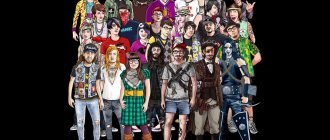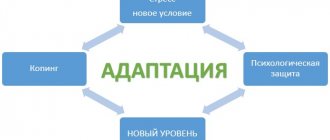Updated July 23, 2021 639 Author: Dmitry Petrov
Hello, dear readers of the KtoNaNovenkogo.ru blog. Subcultures are a phenomenon that fits tightly into our everyday life. Yes, today society strives to erase boundaries and unification.
But just 10-15 years ago, every second (if not the first) teenager identified himself as a member of some youth subculture in an urgent need to stand out.
Today let’s remember our 2000s and talk about this sociological phenomenon, its genesis (what is it?), internal classification and the most striking examples.
Subculture is...
The word itself to designate this social phenomenon came into the Russian language from English by tracing. It’s easy to disassemble Subculture into two components: sub is a native Latin root, an analogue of our “under”, but culture is not difficult to translate.
Thus, a subculture is a “ subculture ”. The term is officially accepted by sociological, anthropological and cultural sciences. Its general interpretation is as follows:
A subculture is a part of a society’s culture that differs in behavior from the prevailing majority. It includes social groups of adherents (how is that?) of this culture.
This concept was first used by David Riesman, a famous lawyer and sociologist from the States. This happened in 1950.
Explaining what a subculture is, he talked about groups of people who deliberately choose values, style, and behavior that are different from the generally accepted ones.
These are individuals who deliberately join the minority because they do not accept the standards of the society in which they live.
In order for a certain social phenomenon that has ideological followers in the form of a clearly defined or conditional social group to be called a subculture, the difference from the dominant culture must be significant. It could be:
- another ideology
- Lifestyle,
- behavior,
- system of values,
- manner of dressing,
- language (slang, sociolect, argot),
- other elements of the same order.
It is important to understand that the main aspects here are ideological, psychological, ideological. Forming your own slang, way of dressing, cliche behavior - all this is only a consequence and a way to show another representative of your group: “ I belong !”
The term "subculture" has historical synonyms that were gradually replaced. Thus, Michel Maffesoli (France) used the combination “urban tribes” when talking about youth groups. Viktor Dolnik (Russia) called them “clubs”.
In the Soviet Union, groups representing youth subcultures were called “Informal Youth Associations.” informals came into use .
Finally, the slang concept of “party” can be used to designate a specific “cell” within a “subculture”.
Hipsters
The subculture of dudes was formed in the second half of the 40s - 50s. At this time, young people dressed in provocative clothes appeared on the streets of cities. Representatives of the movement were distinguished by cynicism in their judgments and indifference to Soviet norms of behavior.
The hipsters of those times protested against standard stereotypes of behavior and monotony in clothing. The subculture undoubtedly left a bright imprint on the Soviet era.
Men-dandies wore tight trousers (“pipes”), long double-breasted jackets, bright shirts combined with colorful ties, pointed boots and dark glasses.
The girls decorated their clothes with sewn bows and a lot of jewelry. Hipsters, as a rule, were the children of high-ranking officials or professors.
Types and examples of subcultures
It is quite difficult to classify this phenomenon; at the moment there are no ready-made studies. professional and youth are often distinguished among them .
They say that teachers have their own “subculture”, because their lifestyle and sociolect may differ from the generally accepted one. And so in any profession.
IMHO (what does this mean?), this is far-fetched: such a division really exists in linguistics when we talk about various slangs, and, apparently, by analogy it was transferred to this area. But can we say that teachers deliberately violate socially accepted norms? Hardly.
But it is more than correct to highlight youth subcultures.
Most different trends have always arisen in the circles of young people and teenagers. This is not surprising, because age itself pushes one to self-expression, rebellion, to express oneself in a way that is contrary to what is generally accepted.
However, this is a kind of super class. It doesn't have an antagonist (who is it?) like old man subcultures (although the grannies on the benches are definitely hiding something).
Youth subcultures include almost all current ideological groups. Therefore, in further division, in each case it is worth remembering that this is, to one degree or another, a youth subculture as well.
It is impossible to provide a complete list of subcultures that have existed in history or exist now. If we make an attempt at classification, then the basis for differentiation (what is it?) must be taken from the phenomenon that served as the impetus for the unification of people. Then we get these types of subcultures.
Freaks
The freak subculture formed in the 20th century in North America. Representatives of the movement adhere to the main idea - to stand out among the crowd of surrounding people. For these purposes, not only clothing is used, but also behavior and philosophy. The term “freak” comes from the English word Freak, which means strange person. Each follower of the subculture strives to create his own unique image.
Freaks are ardent supporters of piercing - they pierce themselves en masse in all sorts of places, and also cover their bodies with tattoos with images, inscriptions and patterns.
Musical subcultures
Music genres are the foundation on which the loudest, most widely known subcultures were built. First of all, this:
- Hippie. One of the oldest youth musical subcultures, which united adherents of the idea of pacifism and rock lovers.
- Rastafarians. Fans of reggae and the legalization of marijuana, whose subculture has received the status of a religious movement (Rastafarianism).
- Metalheads – lovers of metal music. One of the first representatives of a new wave of vibrant subcultures that appeared in the 1970s and 80s. The most important thing is personal freedom.
- Punks. In addition to their love for punk rock, they are united by pure opposition to society, by rabid political rebellion. “Mom - anarchy, dad - a glass of port” - this goes here.
- Goths. Gloomy, melancholic individuals who listen to gothic rock and trudge through the Victorian era.
- Hip-hop culture. Inside, rap, hip-hop and beatbox are distinguished.
- Emo opened a new era of subcultures that opened in the 90s and 2000s.
These are mainly teenagers who demonstrate sensitivity, vivid emotions and a desire for suicide. The musical style is called the same.
Roleplayers are inhabitants of two worlds
Role-players or historical reenactors are another direction of the art subculture.
The role-playing movement is based on a passion for fantasy or history. Each participant in the role-playing game transforms into a specific character and acts according to the script. The game can be based on both historical events and plots of works in the fantasy style.
Participants try to replicate living conditions, costumes, crafts, and battles of a particular era as faithfully as possible. Vikings, Ancient Rus' or medieval knightly battles are popular among roleplayers.
A separate direction of the role-playing movement are Tolkienists - fans of J.R. Tolkien. Participants in this subculture transform into characters from his books: elves, orcs, gnomes, hobbits, acting out scenes from the universe invented by the writer.
In ordinary life, participants in the role-playing movement may not stand out from the crowd, but many prefer unusual jewelry and clothes that are stylistically close to the character’s costumes; many create accounts on social networks on behalf of their hero.
Role-playing games are a form of escapism, a way to escape reality. For some it is a break from the daily routine, for others it is an alternative and more preferable reality. Among role-players you can meet both teenagers and older people.
Urban subcultures
These are what we can rightly call “urban tribes.” These include:
- Roofers . They explore abandoned buildings, old industrial or social facilities. They also climb onto the roofs of high-rise buildings.
- Diggers . They travel through underground passages and structures.
- Cybergoths , also known as cyberpunks (see what steampunk is). Genesis of books and games. These are fans of the idea of a man-made apocalypse and life after it. Designed for industrialization.
- Stalkers. They travel to prohibited zones and closed areas.
Some include here hooligans who do not consider themselves a subculture.
But you can add bikers , who often find themselves outside the classifications. These are people for whom the motorcycle has become a way of life. The cult of wheels, roads and complete freedom.
Afterword
Not all young people from subcultures manage to socialize successfully.
- For some, the subculture becomes just a stage of entertainment, an assistant in finding themselves and their place in society.
- For some, it is a stage before the onset of criminal or addictive behavior. For example, a passion for the Rastafarian culture can result in both successful socialization and the use of hard drugs, i.e., drug addiction. Activists of the pink rock movement can become representatives of gay movements, and goths can “grow” into Satanists.
- In addition to the two mentioned above, there is a third scenario for the development of events for the informal – permanent life within the subculture (“eternal informals”). These people are not taken seriously either by society or by representatives of their own subcultures. As a result, such people do not live, but exist within a very narrow framework, prescribed by them, and in an independently created illusory world.
The energy of youth needs to be channeled in the right direction. It rarely happens that it is impossible to redirect a young person from a destructive and antisocial subculture to a prosocial one. Most often, he just wants to get carried away with something, to be involved, and does not adhere to specific deep-rooted beliefs. Therefore, it is only necessary for him to present an alternative to his subculture in an interesting and competent way from the side of psychological and pedagogical science.
It is necessary not to fight subcultures, but to accept them and communicate in their own language, help in organizing leisure time, and take an interest in their lives. Focus on the benefits of subcultures (development of youth abilities, support in socialization, progress of society). Promote the development of prosocial creative groups.
Countercultures
The oldest and most established counterculture of the world of organized crime (for example, AUE), based on the concepts of thieves. It has its own hierarchy, laws, rules. Its own musical culture (thieves' song), tattoo.
Another striking example is skinheads . This counterculture has a musical genesis (from reggae and ska), but it has moved far from those roots.
Subsequently, skinheads became deeply politicized. This is how Nazis, anti-communists, etc. appeared.
Skinheads or skinheads
The members of this group, like the rockers, predominantly came from low-skilled workers. Among them, many were unemployed, poorly educated and with a low cultural level. Skinheads wore jeans rolled up at the bottom, large, rough shoes, and shaved their heads. Football hooligans are closely associated with the skinheads. These types of subcultures are largely similar in social composition. They are also united by aggressive behavior, for example, associated with football matches.
Hippie movement
This subculture appeared in the USA in the 60s and very quickly spread throughout the world. At one time, hippies evolved from the beatniks, representatives of the middle class, who for a long time influenced the people of their group. These American subcultures have one common distinctive feature - an ideology clearly expressed in words. The main elements of the hippie style or worldview were the following:
- Peacefulness and non-violence. Pacifism was the main hippie ideology. That is why representatives of this group were distinguished by their disregard for power and apoliticality, since it is the rulers who incite wars and force people to fight.
- Self-development and individualism. These elements were a reaction to the dullness of mass society.
- Conscious simplification, that is, the transition from a prosperous life to poverty, the rejection of material wealth.
- Drugs, sexual experiments, travel, festivals, communes - all these are the most striking features of the hippie subculture.
- Living together is a distinctive feature of hippies, as other subcultures did not adhere to this form of behavior.










